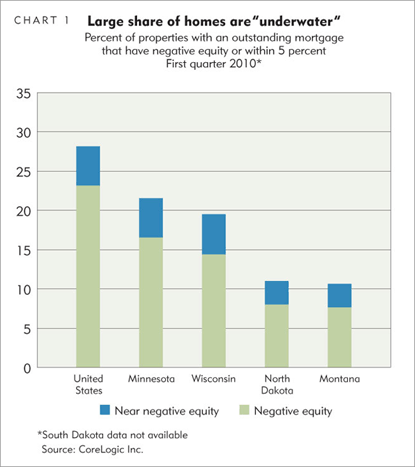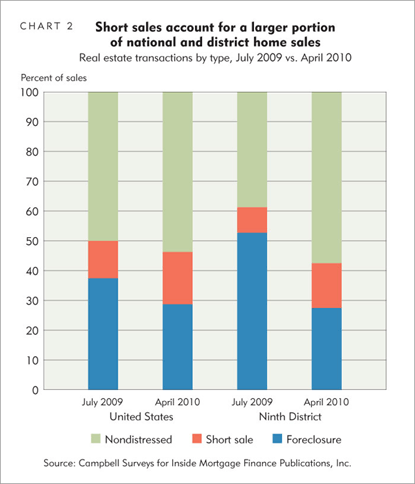When one of Blaise Johnson’s clients fell behind on his mortgage last year, things looked dire. The Fargo, N.D., homeowner needed to sell, but in a real estate slump, his house was worth less than the amount he still owed the bank. If it had gone into foreclosure, he not only would have lost his home, but he also would have had difficulty buying another for years to come because of a poor credit record.
In the end, the client staved off foreclosure, thereby doing less damage to his credit standing. Johnson, director of lending for Gate City Bank in Fargo, worked out a deal in which the homeowner sold his house for what he could get and agreed to make up the $3,000 shortfall—the difference between the sale price and the balance owed on the mortgage—out of his own pocket.
This transaction is a simple example of a short sale, in which the homeowner sells for less than the mortgage amount, often making some arrangement to pay all or part of the outstanding balance. Short sales have become an increasingly popular escape hatch for financially distressed homeowners who need to sell in a still-hurting housing market.
Market survey data indicate that, nationwide and in the Ninth District, short sales are growing, although the rate of growth varies, typically in sync with the underlying health of a region’s housing market.
In March, roughly one in 10 homes sold in the Twin Cities metro area was a short sale, according to the Minneapolis Area Association of Realtors (MAAR); in 2006, that statistic was closer to one in 100.
Data on short sales aren’t available for many smaller markets in the district, but interviews with real estate sources suggest that they’ve become more prevalent. “We’ve seen a lot of activity with short sales, and a lot of interest from first-time home buyers,” said Brint Wahlberg, a real estate broker in Missoula, Mont.
Given the state of the housing market—sagging values and large inventories of foreclosed homes in many parts of the district—it’s not surprising that short sales have caught on. Although they can be complicated and time consuming, in a down market, short sales often work to the advantage of all parties—seller, buyer and lender.
But the surge in short-sale activity is unlikely to last for more than a year or two. Short sales will likely decline when housing prices rebound, allowing home sellers to once again pay off the bank on closing day.
Treading water
Until recently, real estate short sales (not to be confused with short selling in the stock market) were rare. “I couldn’t even spell short sale three years ago,” said Bill Malkasian, president of the Wisconsin Realtors Association.
There isn’t much opportunity to sell a home short when prices are rising, as they were over much of the past 15 years in virtually every district market. For a homeowner struggling to make mortgage payments, the standard solution in a robust market is foreclosure, where the lender takes possession of the home (which has typically appreciated) and sells it to cover remaining debt.
For short sales to occur, it takes two needy parties to tango, and banks aren’t accustomed to accepting losses on their loans. Just a few years ago, most short-sale offers (about 90 percent, according to Wahlberg) were rejected. Lenders usually preferred to foreclose, resorting to short sales only in instances where they had little hope of recovering the value of the home, typically due to fire, flood or some other disaster.
All that has changed with the drop in housing values in many parts of the country and the district. The number of “underwater” homes—those whose owners owe more on their mortgage than the market value of their house—has risen sharply over the past three years. Foreclosures and tighter appraisal standards in the secondary mortgage market have further lowered home values in many areas, driving more properties underwater.
In the first quarter of this year, about 17 percent of Minnesota homes with a mortgage outstanding had negative equity, according to a report by research firm CoreLogic. Even in relatively prosperous North Dakota, 11 percent of mortgages were underwater, or close to it (see Chart 1).
Coming up short
In this troubled market, short sales have gained traction as an alternative to foreclosure. In the nation and in the district, short sales have increased in numbers and as a proportion of both total housing sales and distressed sales (those where the owner is compelled to sell).
Nationwide, short sales grew from less than 13 percent of total transactions last July to 18 percent in April, according to a survey conducted by Campbell Communications for the trade publication Inside Mortgage Finance. Short sales’ share of distressed transactions increased even more over the same period, from 25 percent to 38 percent (see Chart 2).
In the district, where the housing crash hasn’t been as severe, short sales make up a smaller proportion of total sales. But short selling has increased dramatically over the past year. The Inside Mortgage Finance survey found that in district states (excluding portions of Michigan and Wisconsin within the district), short sales increased from 9 percent of transactions last summer to 16 percent in April. District short sales as a share of distressed sales increased even more over the same period and outpaced national gains.
The Twin Cities saw a big jump in short sales in 2009, and that trend continued this spring, although at a slower pace. As of March, the number of short sales in the Twin Cities area had risen 52 percent from a year earlier, according to Multiple Listing Service (MLS) data compiled by MAAR.
As short sales have increased to account for over 10 percent of all home sales in the Twin Cities, foreclosures have declined. From early 2009 to early 2010, “lender-owned” sales fell 38 percent in the metro area. MLS data are less informative for other metro areas in the district. Several realty associations, including those in western Montana, South Dakota and northwestern Wisconsin, didn’t begin tracking short sales until 2009, in response to signs that activity was increasing.
But real estate sources provide further evidence of an increase in short sales. In Sioux Falls, S.D., First Dakota Title handles the details of housing transactions around the state, including payments to mortgage holders. Vice President of Business Development Mark Wahlstrom said he’s seen more short sales over the past 12 to 18 months than over the past decade.
Lemonade from lemons
In many ways, short sales are advantageous—or at least the lesser evil—for everybody involved in the sale of a home whose value has been battered by the market.
For the lender, short sales offer a way to avoid the often costly and lengthy process of taking possession of a house and trying to sell it in a slow market. By agreeing to negotiate with the owner—in many cases accepting less than the full value of the mortgage—a bank or secondary mortgage holder may recover more of its investment than it would by pursuing foreclosure. Also, holding illiquid assets on the books looks bad to investors and may imperil a bank’s standing with regulators.
For homeowners who are looking to get out from under a mortgage, taking what they can get in the market can be preferable to letting their home slip into foreclosure. While selling short blemishes the homeowner’s credit record, the credit damage often is less severe compared with foreclosure. (The extent to which a short sale impairs a homeowner’s credit depends on several factors—previous credit history, whether the mortgage is delinquent, how many payments have been missed and so on.)
“The credit implications of a short sale versus a foreclosure are better for the homeowner, so there is incentive to short sell, instead of just to walk away,” Wahlberg, of Missoula, said.
And for first-time home buyers and other bargain hunters, short sales offer greater peace of mind than foreclosed properties. Homeowners selling their own houses, rather than turning them over to lenders, are more likely to keep them in good shape.
However, not every short sale is as cut and dried as the one Johnson arranged for his client. The bigger the difference between the sale price and the balance owed on the mortgage, the more leery of the deal the lender becomes. Further, many home sellers who take the short-sale route have second mortgages or home equity loans that they still must pay off. This can complicate and drag out a potential short sale, making it less attractive to both seller and buyer. “It isn’t always the best process, and people do get frustrated,” said South Dakota’s Wahlstrom.
The new normal?
Short sales are a lagging indicator of the downturn in the housing market rather than a new trend in home financing. The short-sale tide may continue to rise for a while; respondents to the April Inside Mortgage Finance survey indicated that the supply of district homes on the market listed as short sales was growing faster than stocks of foreclosed properties and traditional, nondistressed houses.
But since short sales only make sense for underwater homes, they are expected to decline when housing prices start climbing again. When that will happen is anyone’s guess.
Malkasian noted that as long as a huge inventory of distressed, unsold homes exists, homeowners and banks will resort to short sales to find buyers. “I still think we have, in Wisconsin, another couple years to go before we unwind all of this,” he said.
Wahlberg isn’t sure when housing prices in Montana will return to normal—whatever that means, considering the peaks and valleys the market has seen in recent years. “You could say that right now is going to be the new normal for the next couple of years,” he said.
Joe Mahon is a Minneapolis Fed regional outreach director. Joe’s primary responsibilities involve tracking several sectors of the Ninth District economy, including agriculture, manufacturing, energy, and mining.







